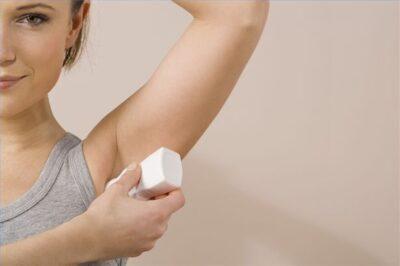
Image source: ehow
One of the last frontiers in your endeavor to live an all-natural lifestyle may be located right under your arms. For most of us, applying a store-bought antiperspirant or deodorant is something we do each morning without really thinking about it. It’s time to think about it.
Most commercially made deodorants contain ingredients such as aluminum, triclosan and parabens. These chemicals have been linked to a variety of conditions ranging from Alzheimer’s disease to breast cancer in laboratory animals, yet we routinely apply them to our skin where they can be absorbed into our bodies. Why? Because we don’t want to have body odor, and these products are effective in masking it.
There are several natural deodorants on the market that provide a safer alternative, but the easiest and most affordable option is to make your own deodorant for your family. The recipe is surprisingly simple.
Before we get to how to make it, however, it is important to understand the difference between deodorant and antiperspirant.
Basically antiperspirants create a barrier that prevents your sweat from reaching the surface of your skin. Antiperspirants are usually made with water solvent ingredients such as aluminum. The main purpose of a deodorant is to mask odor. Commercial deodorants are often made with antibacterial ingredients such as triclosan. Many commercial formulas are an antiperspirant-deodorant combination to offer consumers the best results. Both products often use phthalates, which can alter the body’s hormone balance, to maintain color and fragrance.
Hundreds of projects, step-by-step sequences, and illustrations on real Back To Basics skills…
It’s important to realize that when you make the switch from a commercial antiperspirant to an all-natural deodorant, you will perspire. Keep in mind, however, that perspiration is a natural process that helps your body rid itself of toxins. Scientists believe that body odor is largely determined by genetics, health and personal hygiene. Another determining factor is our diet.
Research studies reveal that when the refined sugar content of junk foods gets into our body systems and combines with bacteria on the skin – particularly in the closed-in area of the armpits — unpleasant odor can occur. Processed foods also lack chlorophyll, which can serve to cleanse the body and to neutralize the bacteria that causes body odor.
Even if you eat a healthy diet, you can expect to go through a bit of a transition period when you switch to a natural deodorant. If you have been blocking those underarm glands for years with an aluminum-based product, it may take a few weeks for your body to adjust to the change.
If you are ready to give homemade deodorant a try, here is a recipe to consider. In the meantime, save the plastic packages your commercial brands come in. You can clean them and then re-purpose them for your new deodorant. Hey, cutting down on plastics is another benefit!
What You Need:
- 1/4 cup baking soda
- 1/4 cup organic cornstarch
- 5 tablespoons coconut oil
- Three drops of essential oil (optional)
- Glass jar with a lid
Mix all ingredients well in the glass jar until they are blended well and have a creamy consistency. Apply the mixture to your underarms with your fingers and store the mixture in the covered jar. Another idea is to pack the mixture into your clean old antiperspirant container and apply.
Here are a few tips:
- Since coconut oil is solid at room temperature, try kneading it to make it softer for mixing.
- Coconut oil can melt in the summer heat. You can place your mixture in the refrigerator for about 15 minutes to help solidify it. You can store it in the refrigerator if necessary. You can scrape out the amount of deodorant you want to apply and warm it with your hands before applying to your underarms. It will absorb in quickly.
- If you prefer, you can substitute shea butter or coca butter for the coconut oil, but coconut oil’s natural antibacterial properties seem to work better on odor.
- Another way to maintain a solid consistency of your homemade deodorant is to substitute a small amount of beeswax for part of the coconut oil content.
- Apply the deodorant lightly and gently massage it into your skin for best results.
- Much of the cornstarch on the market can contain GMOs. Arrowroot powder can be an effective substitute for cornstarch.
- Tea tree oil has a distinctive smell that may take some getting used to, but it helps kill odor-causing bacteria. Rosemary, lavender and lemon essential oils are also good options and can be used instead of or in combination with the tea tree oil.
Everyone’s body is just a little bit different when it comes to how much we perspire and whether our sweat has an unpleasant odor or not. Feel free to experiment with the quantity you apply and how often you apply your homemade deodorant until you find what works for you. Check with your doctor before using essential oils on your skin if you are pregnant or nursing a baby.
You’ve simplified much of your lifestyle already. Why not try this next step? Once you get the hang of it, you’ll find homemade deodorant to be simple and effective.
Have you ever tried homemade deodorant? What tips do you have? Let us know in the comments section below.
Sign up for Off The Grid News’ weekly email and get $600 worth of survival blueprints … free!
 Off The Grid News Better Ideas For Off The Grid Living
Off The Grid News Better Ideas For Off The Grid Living




